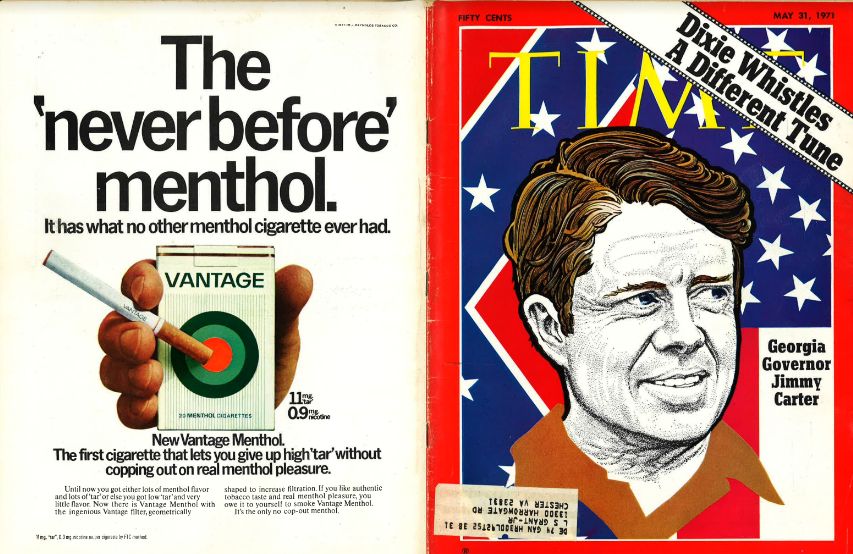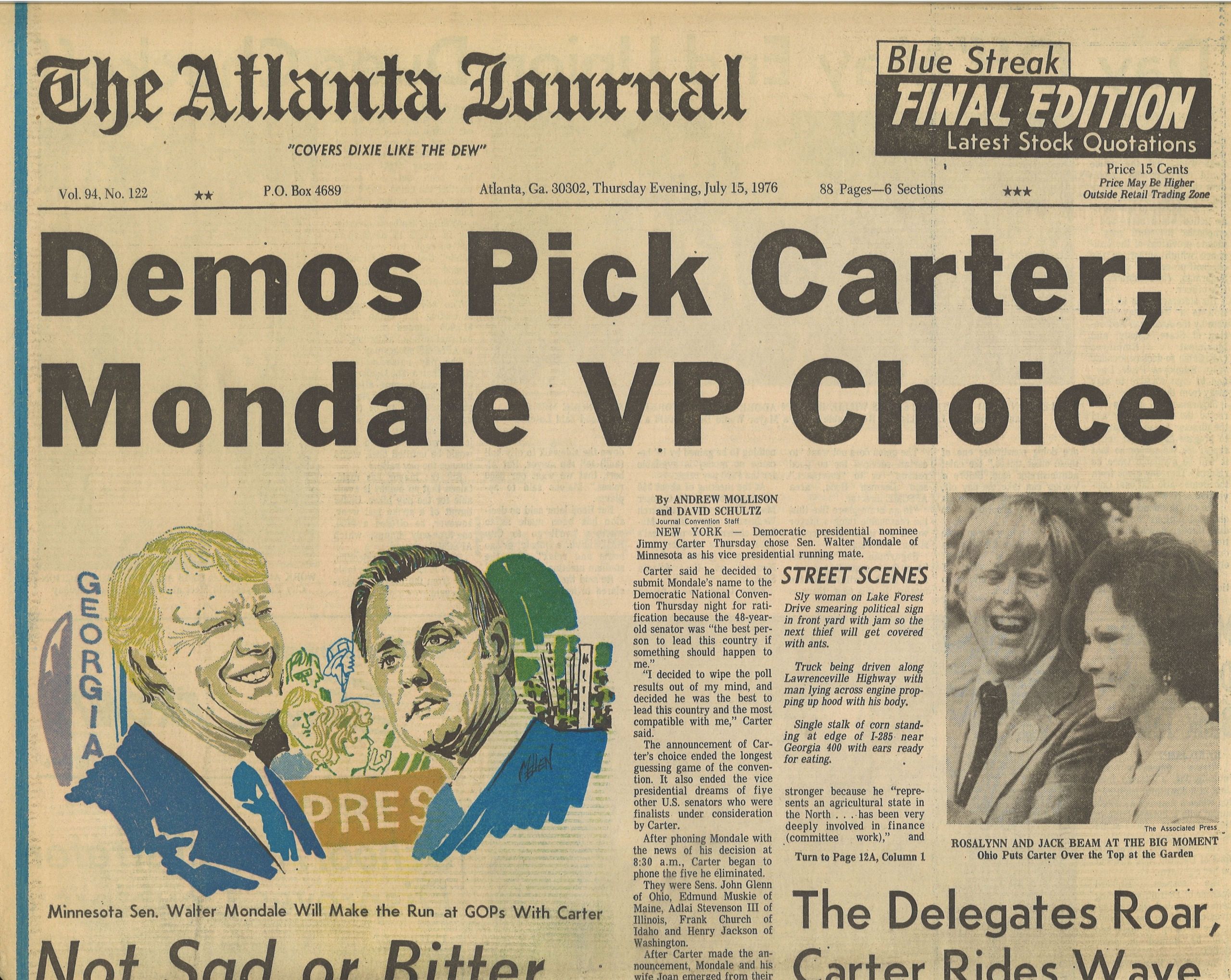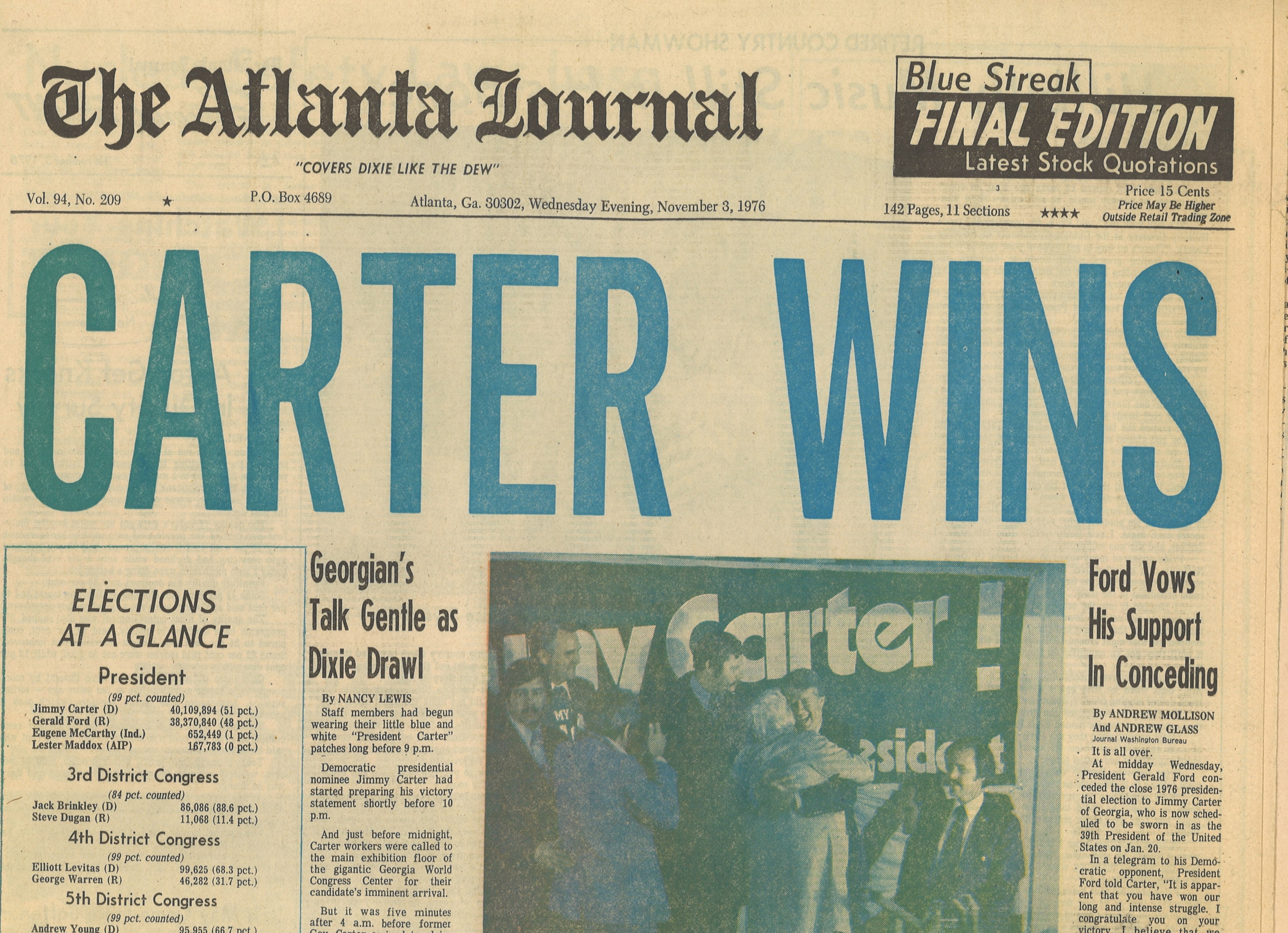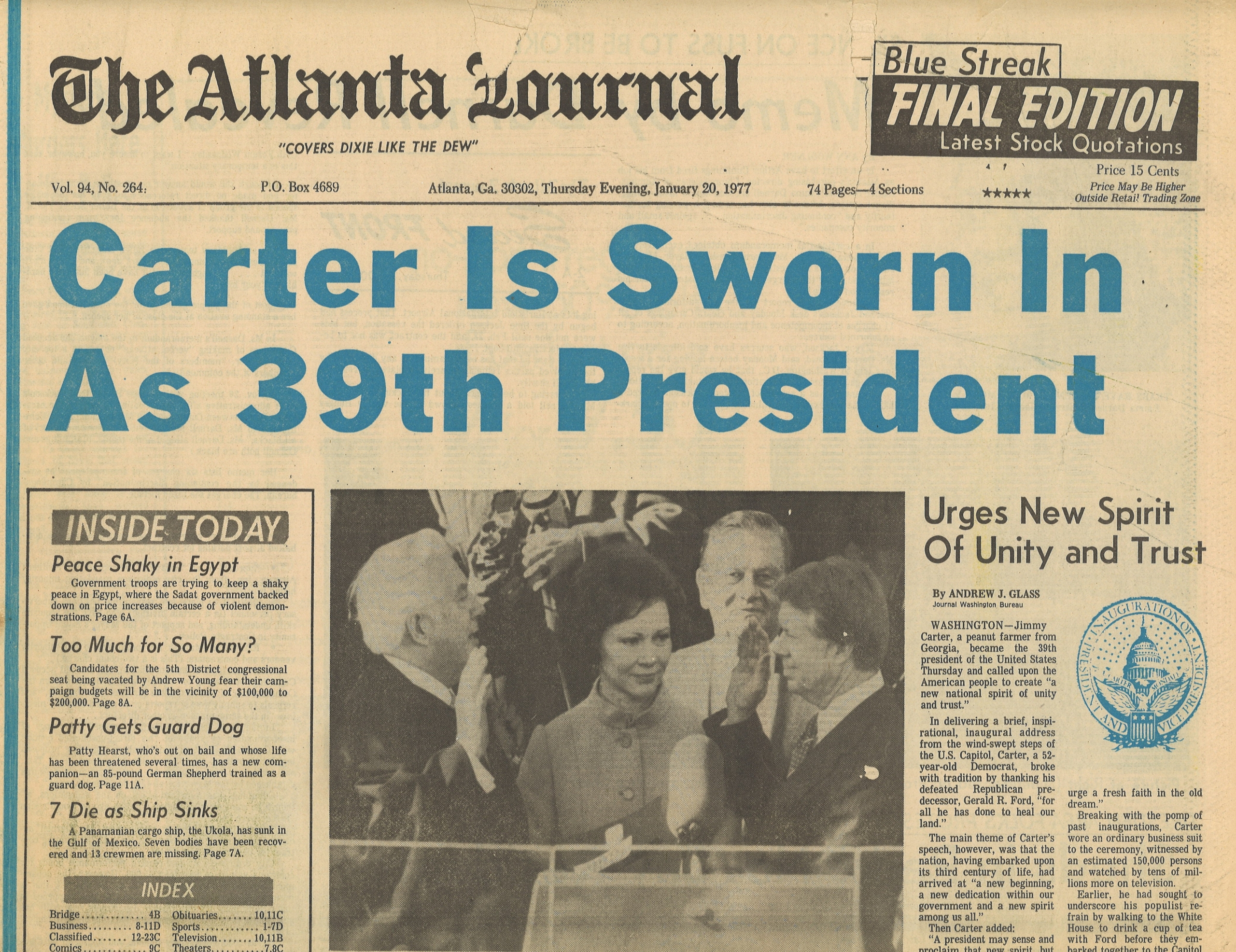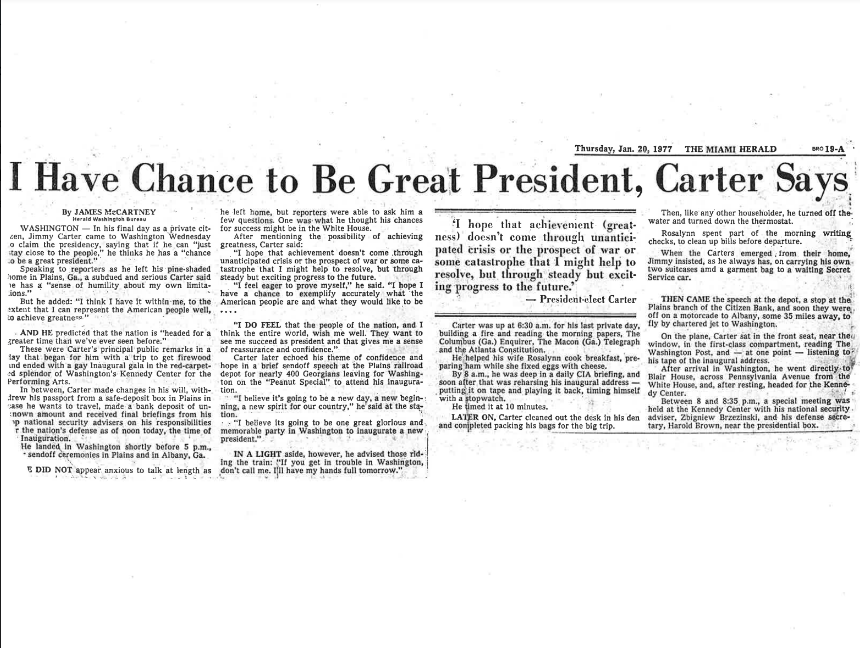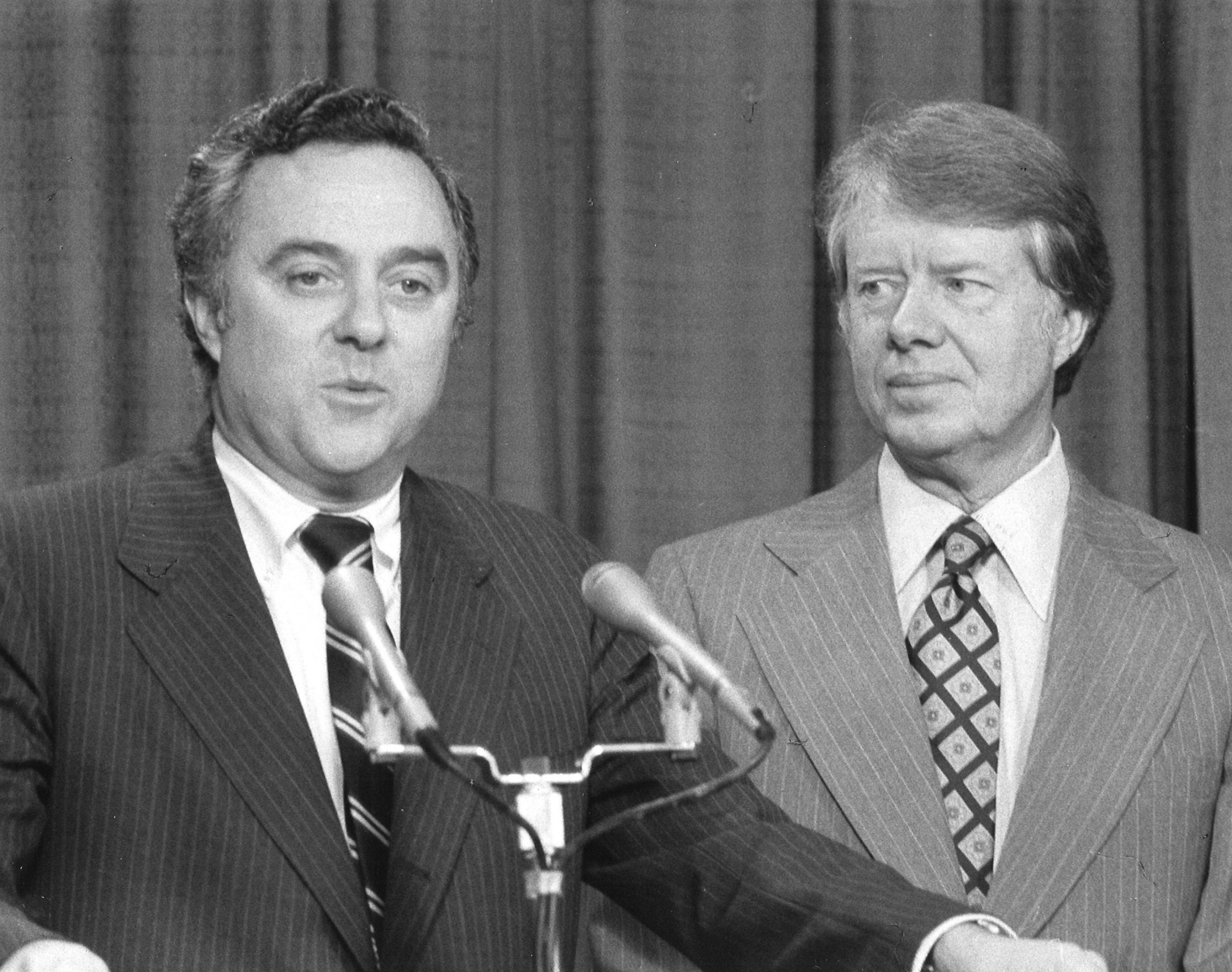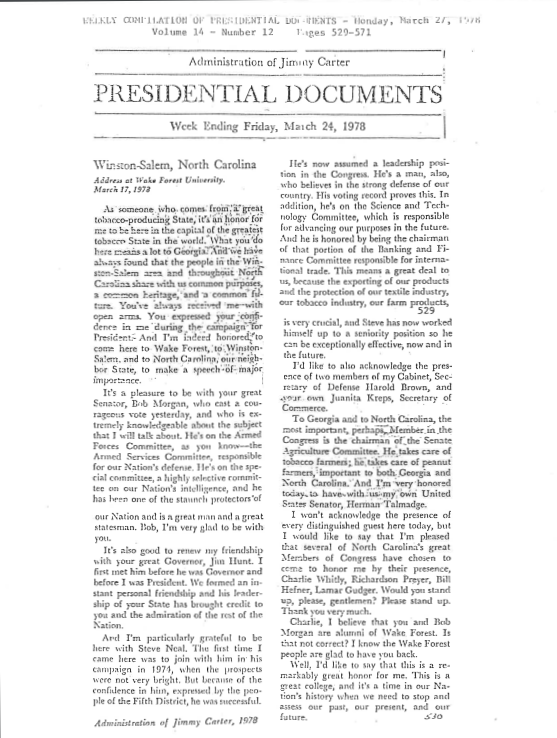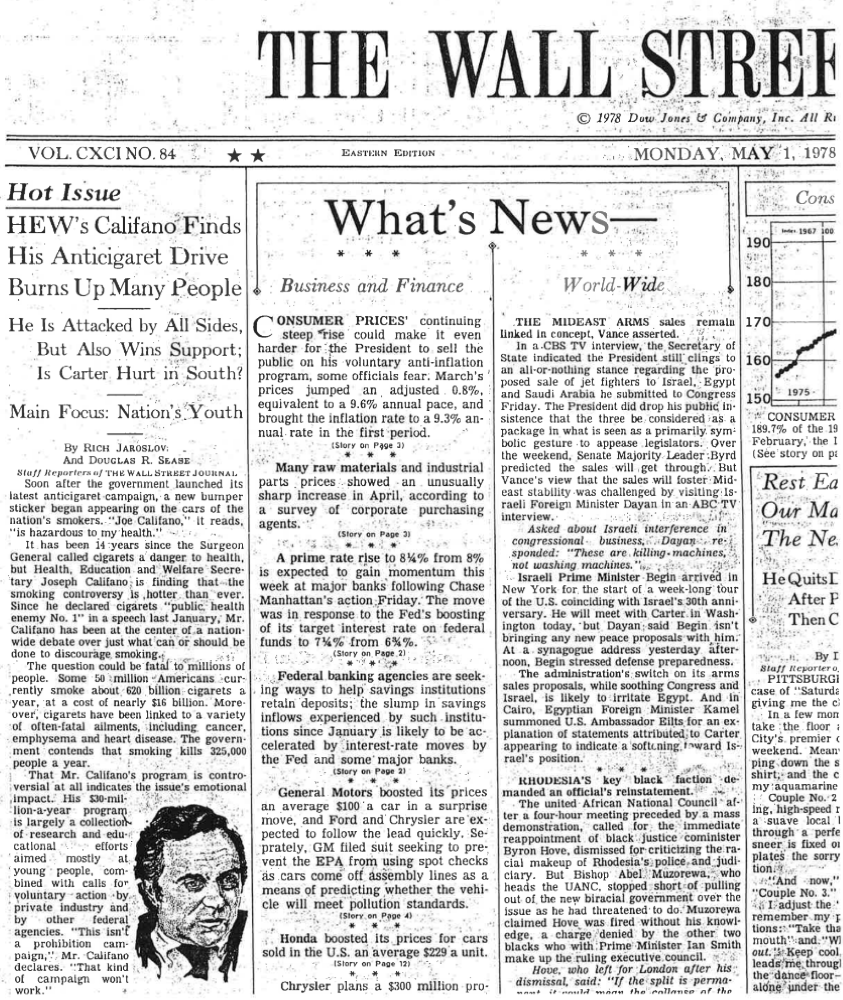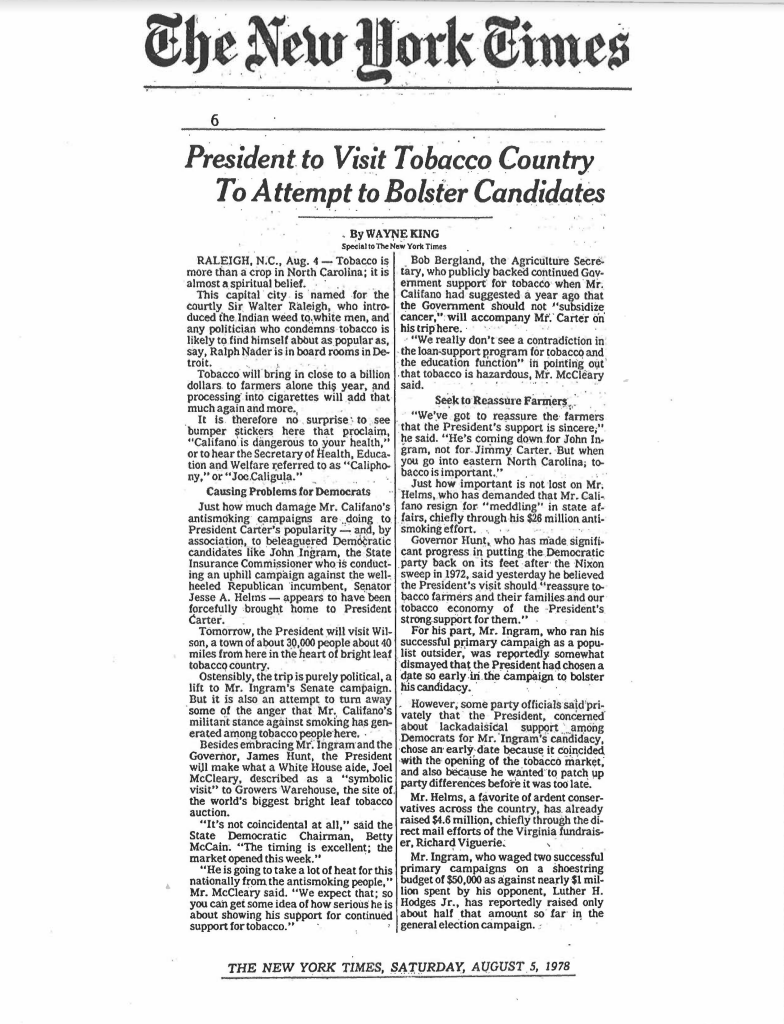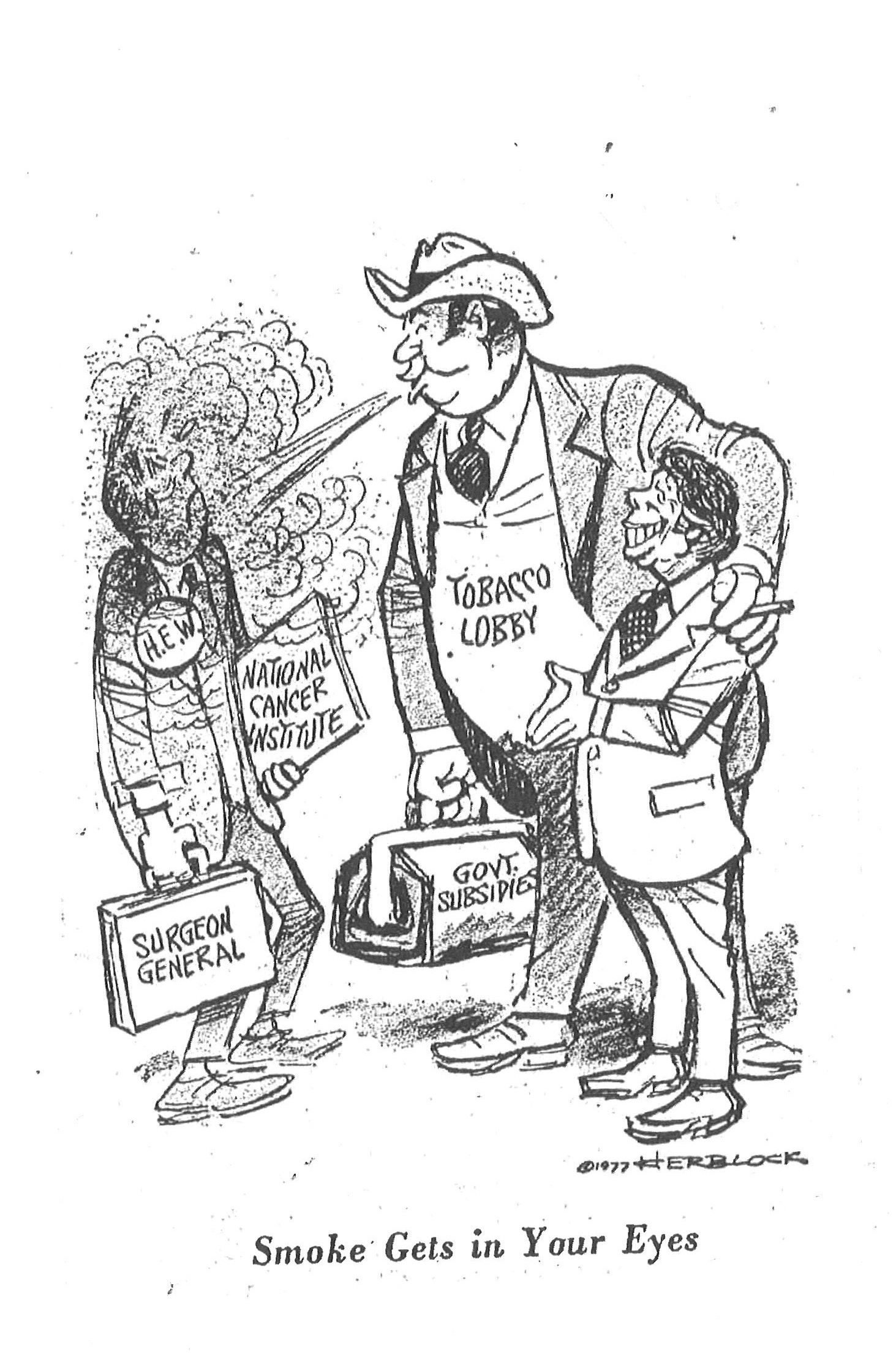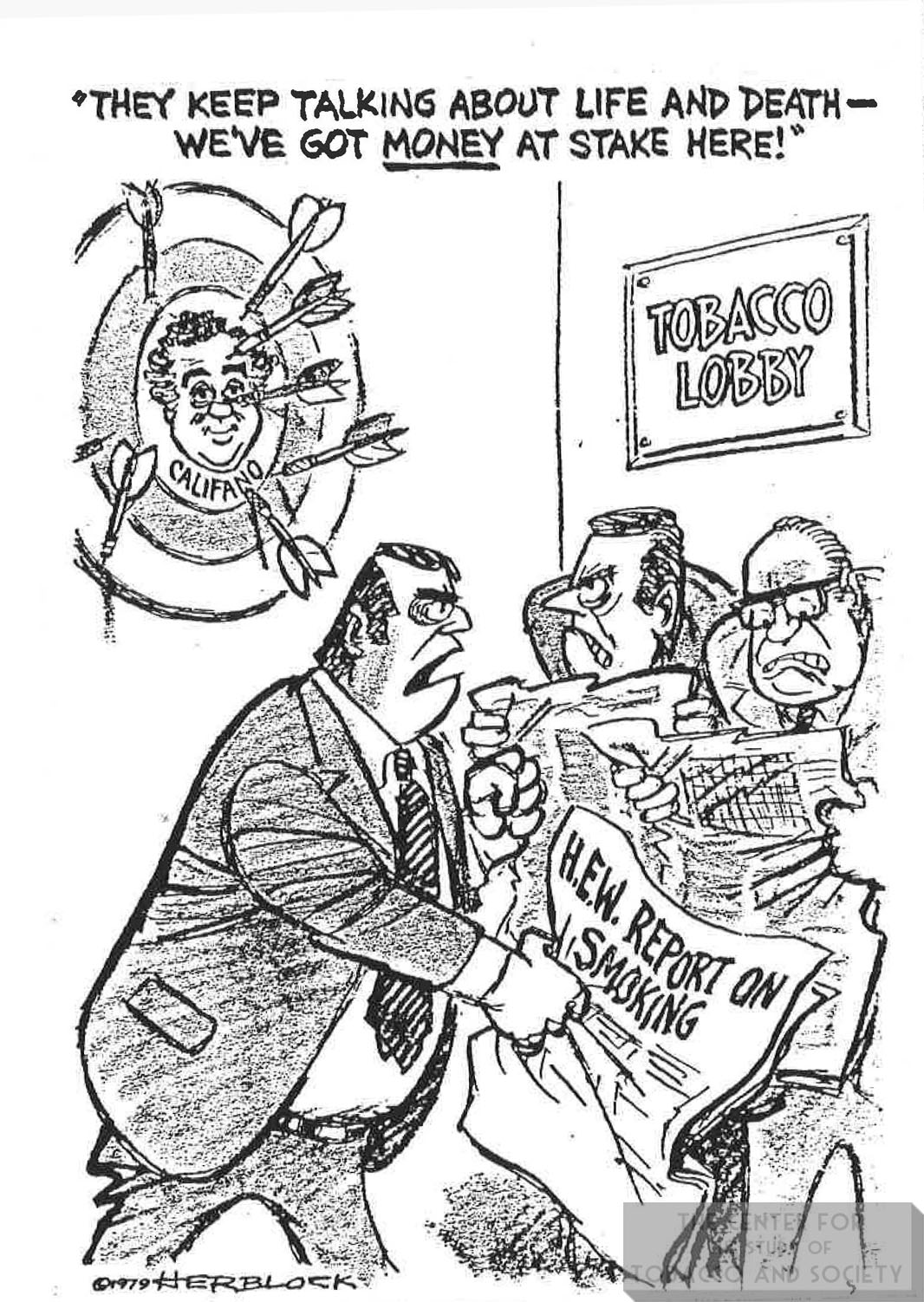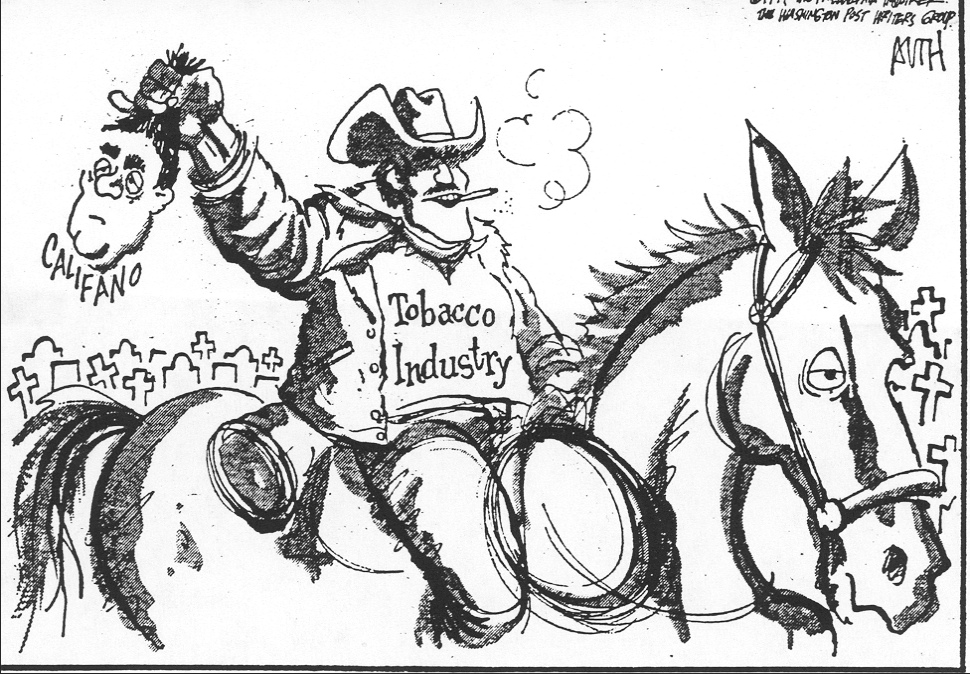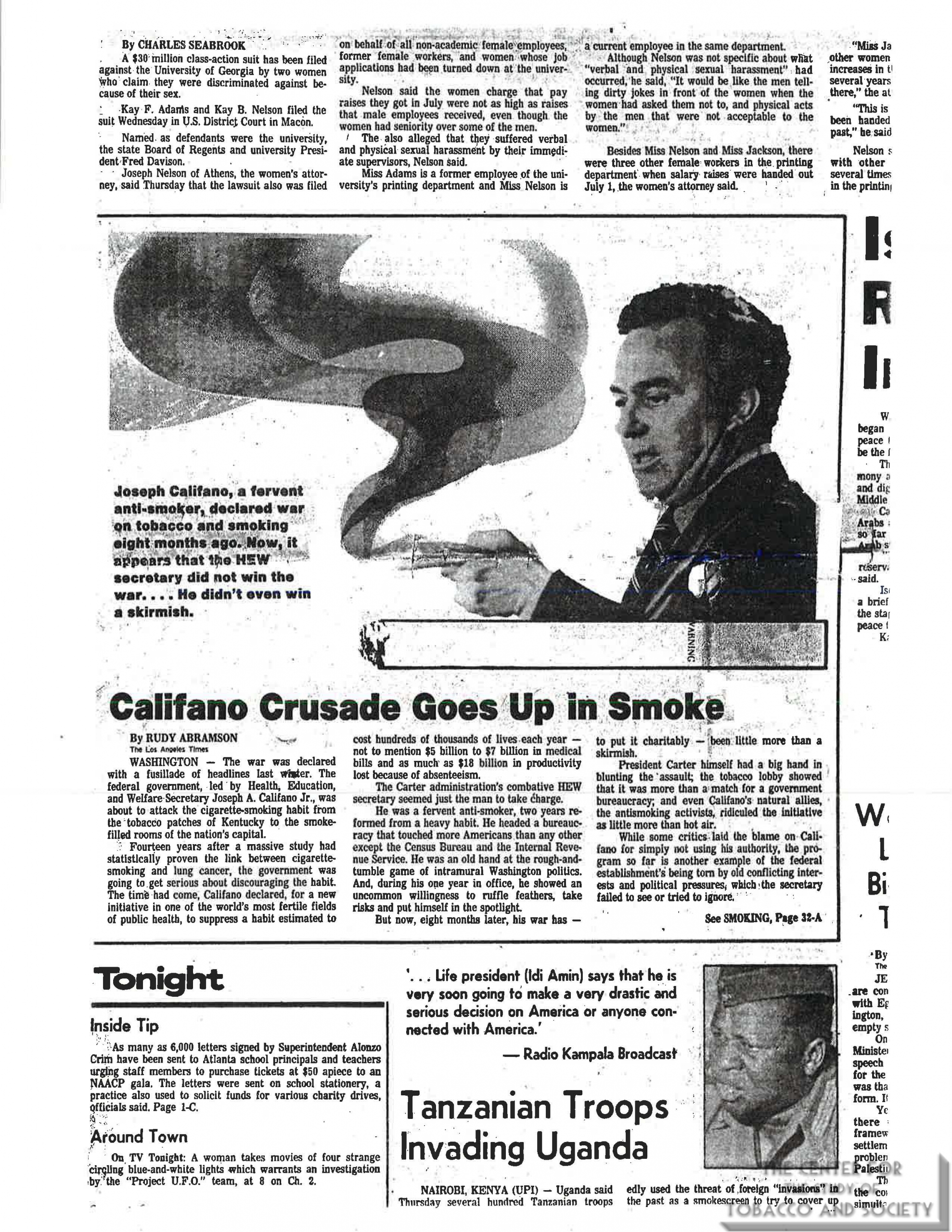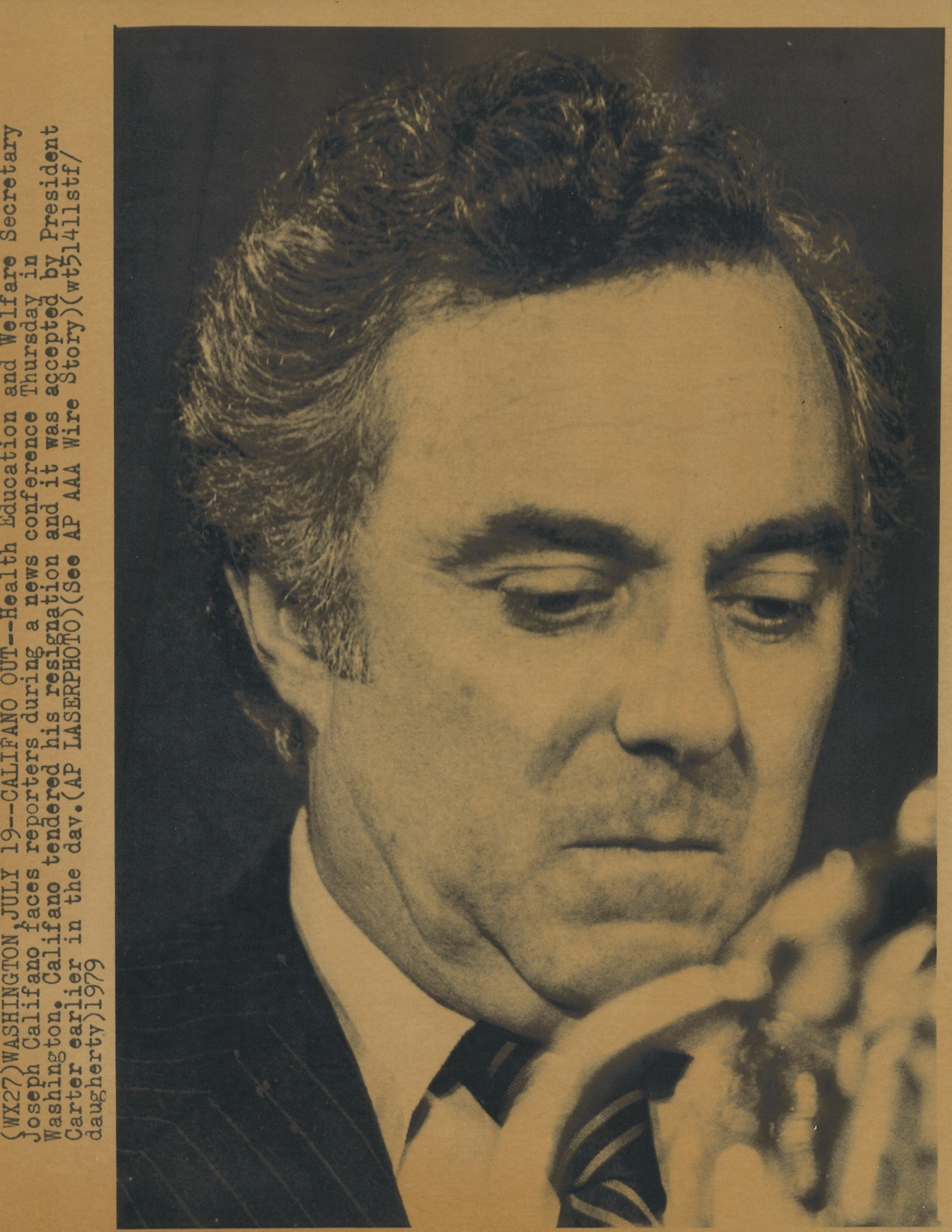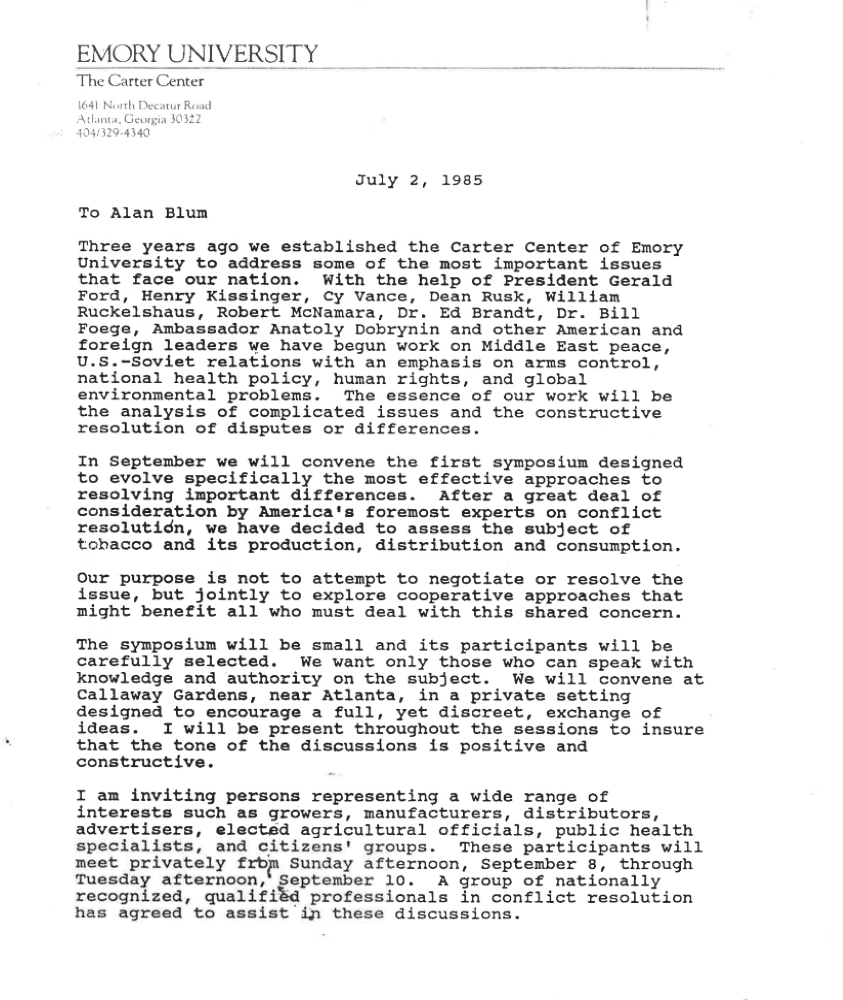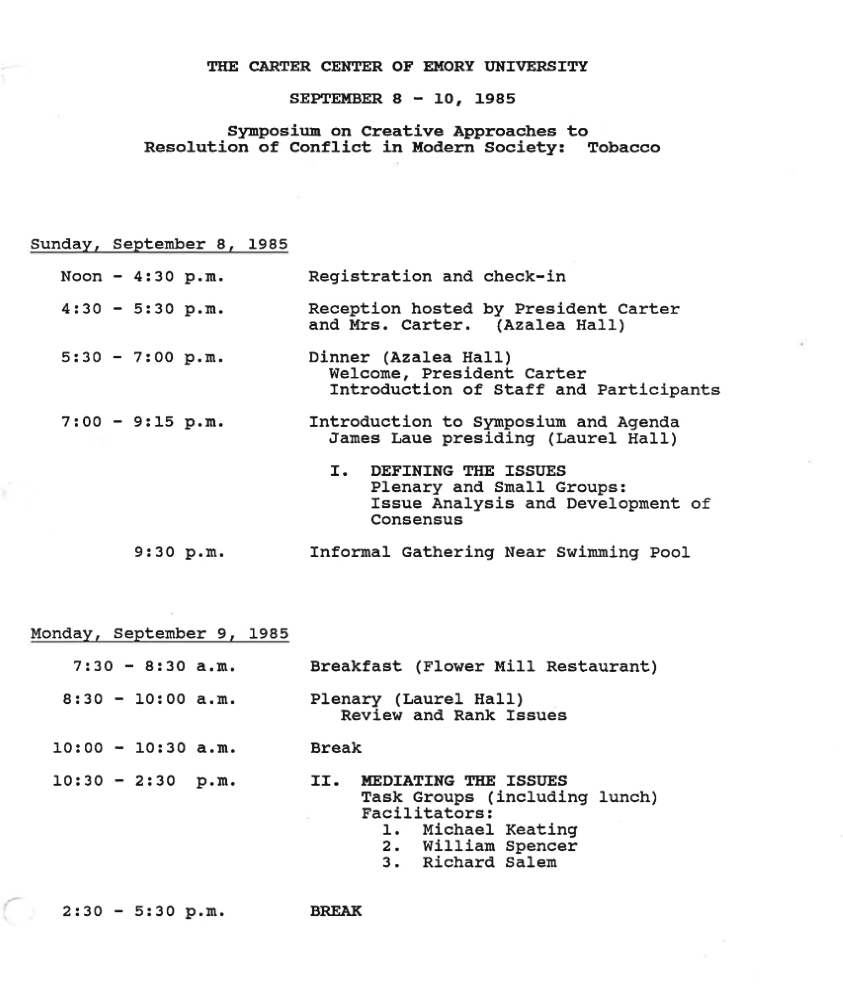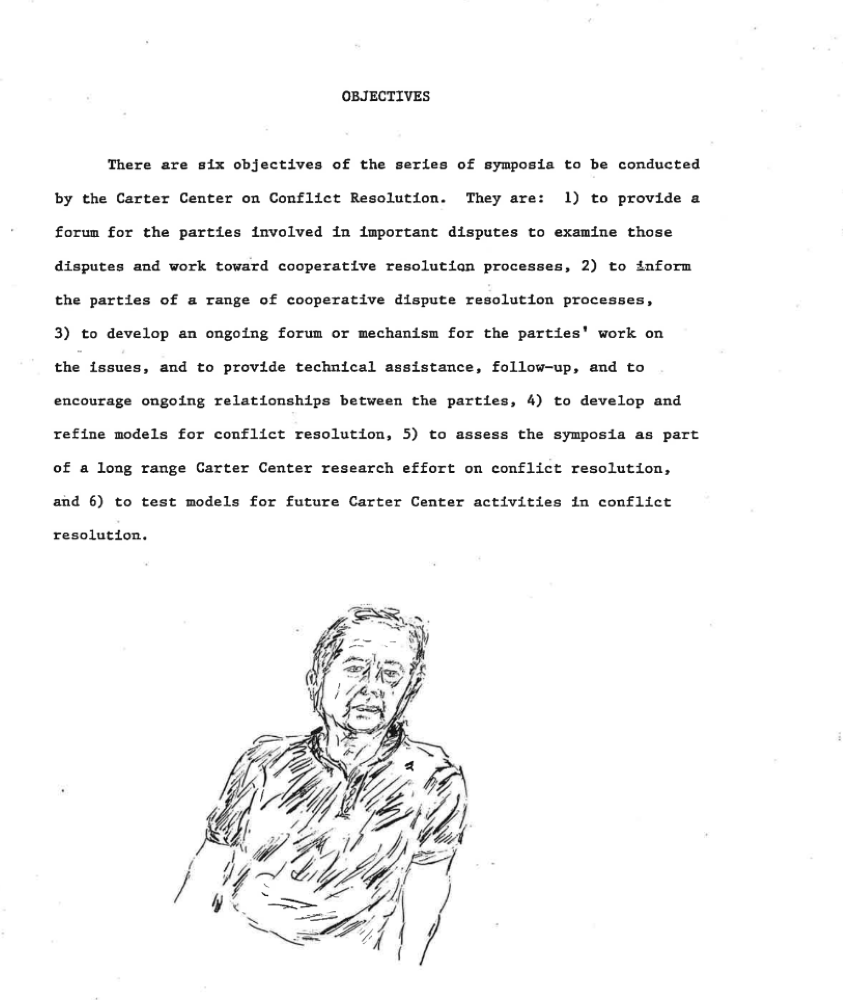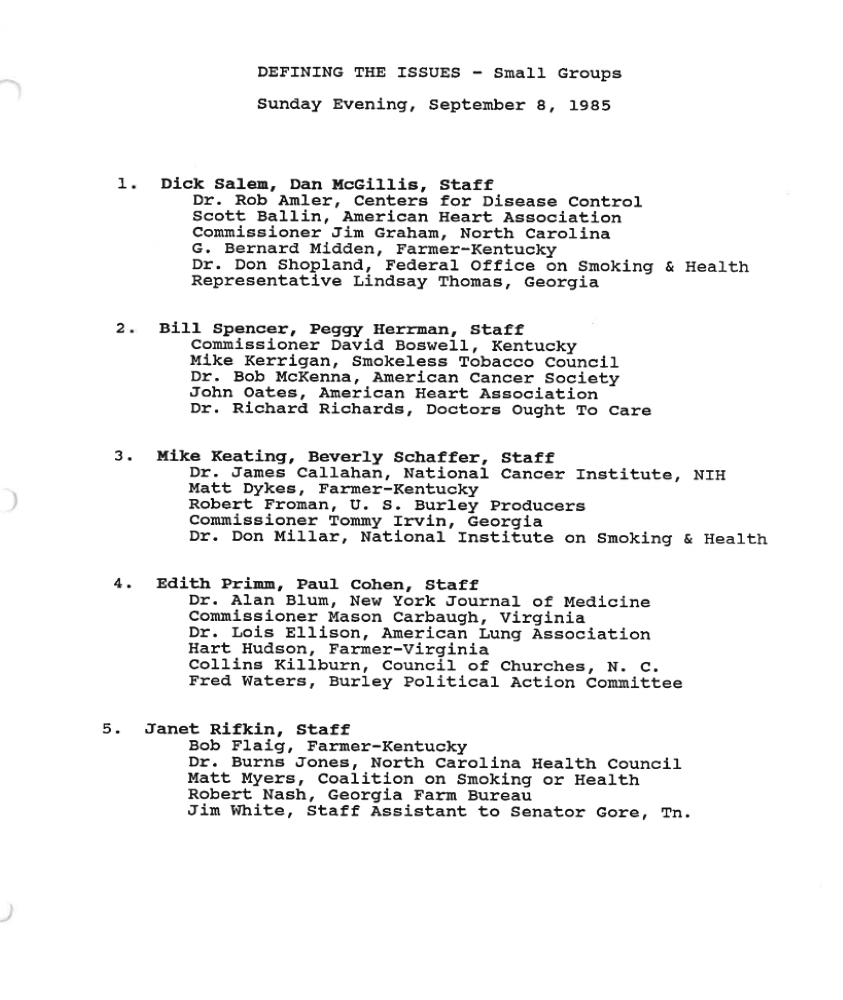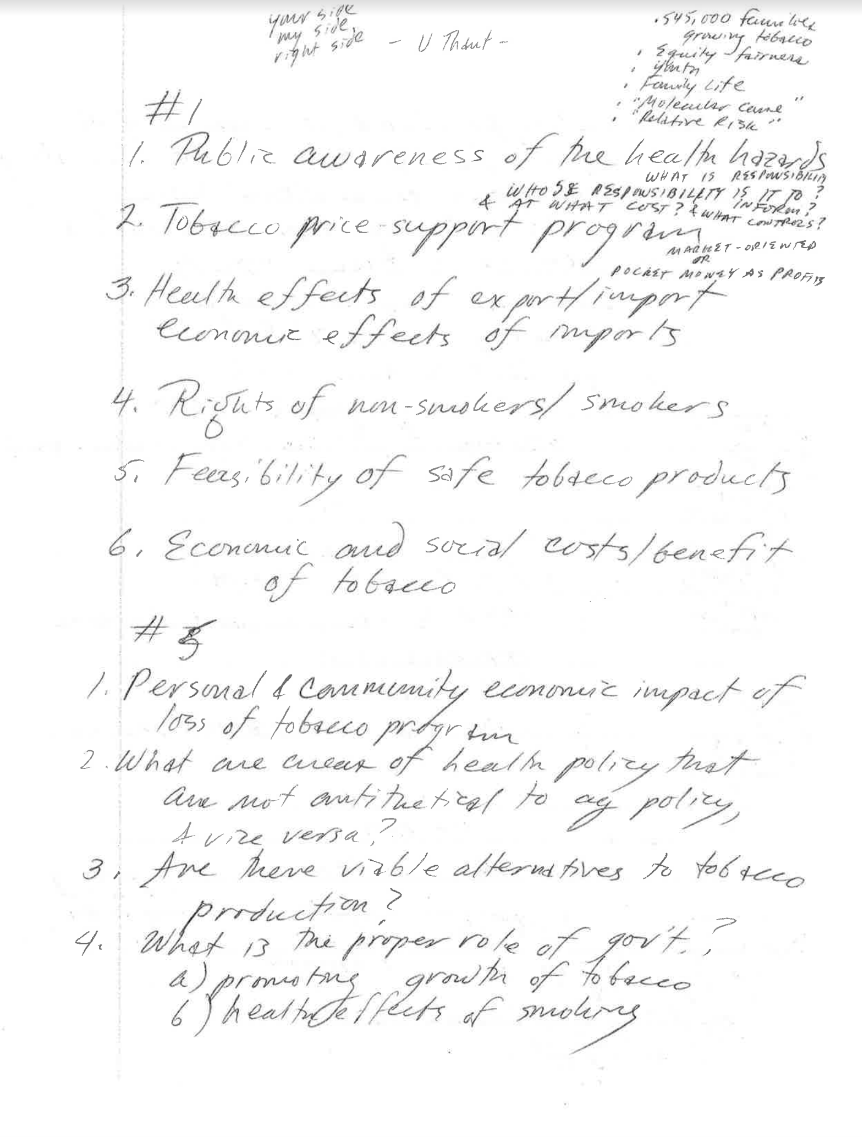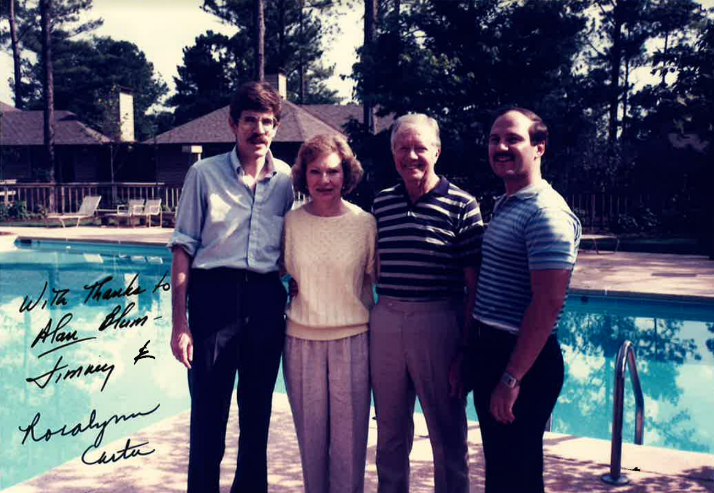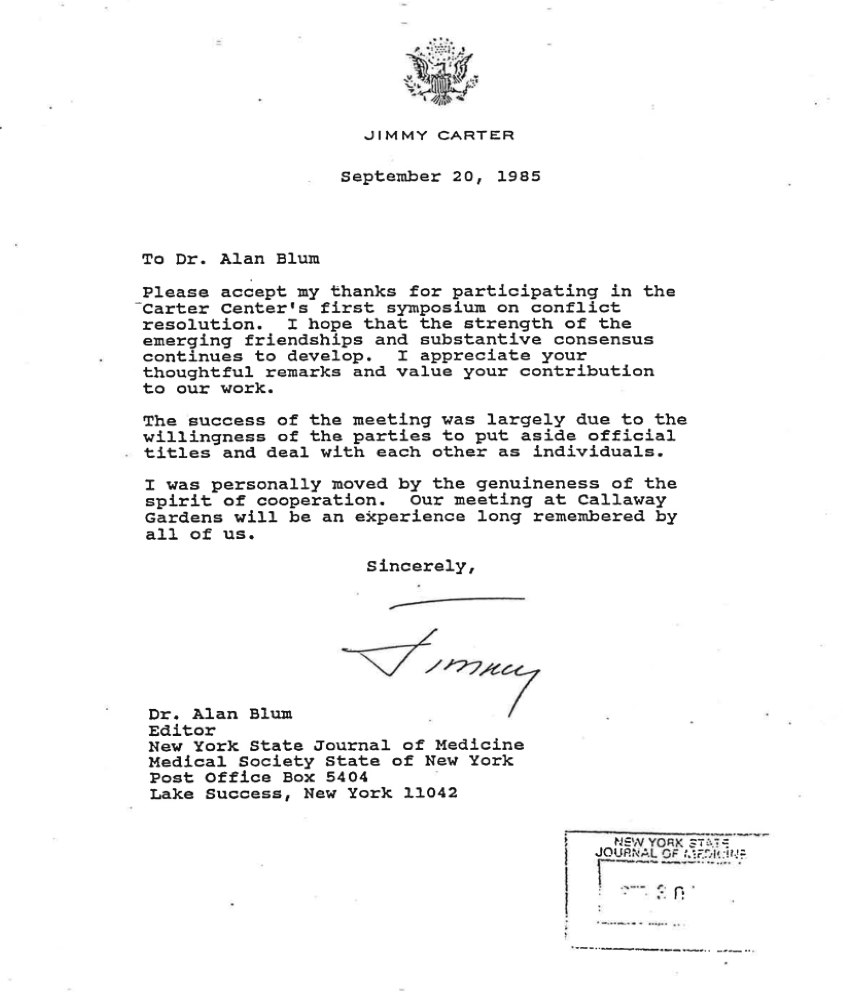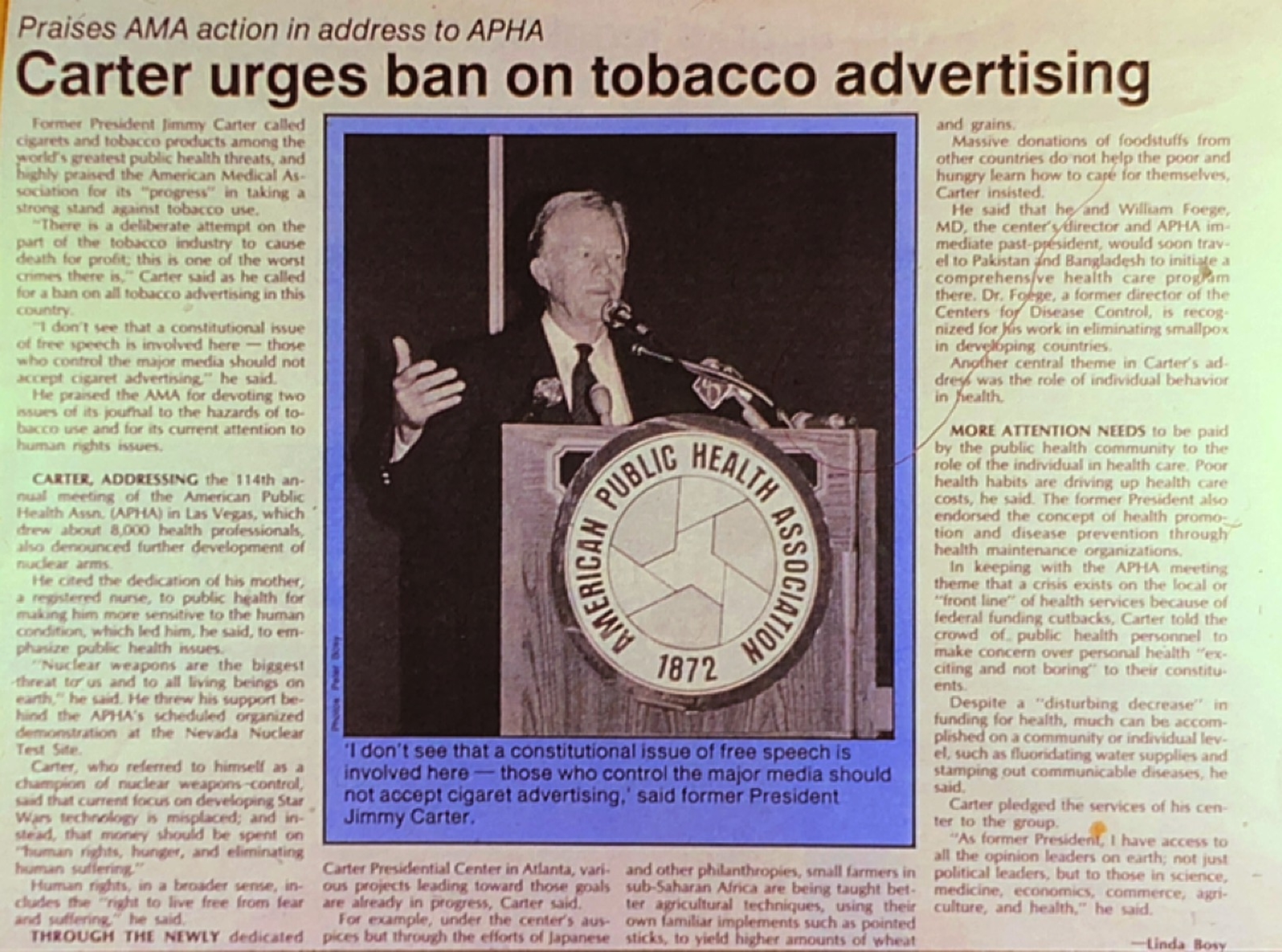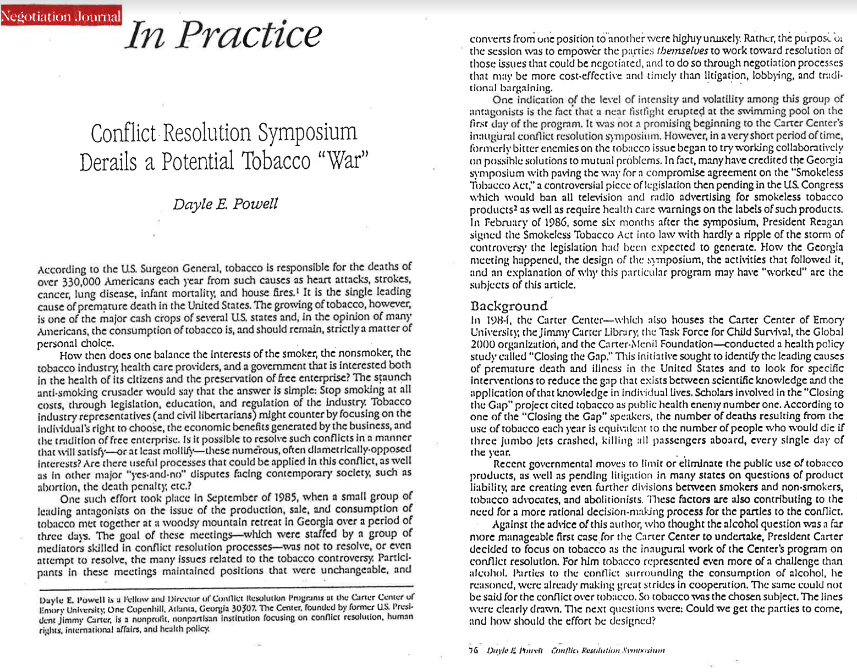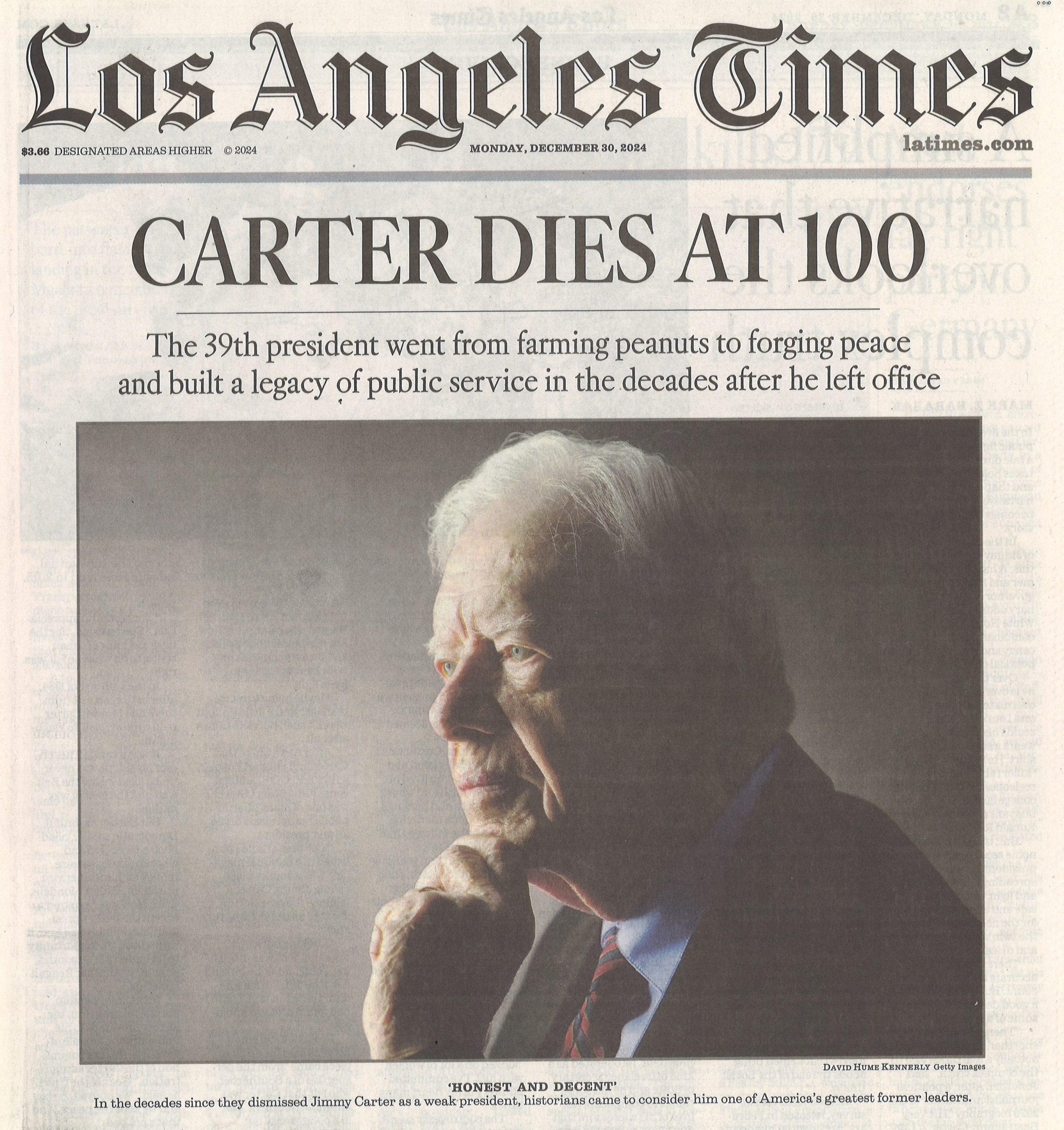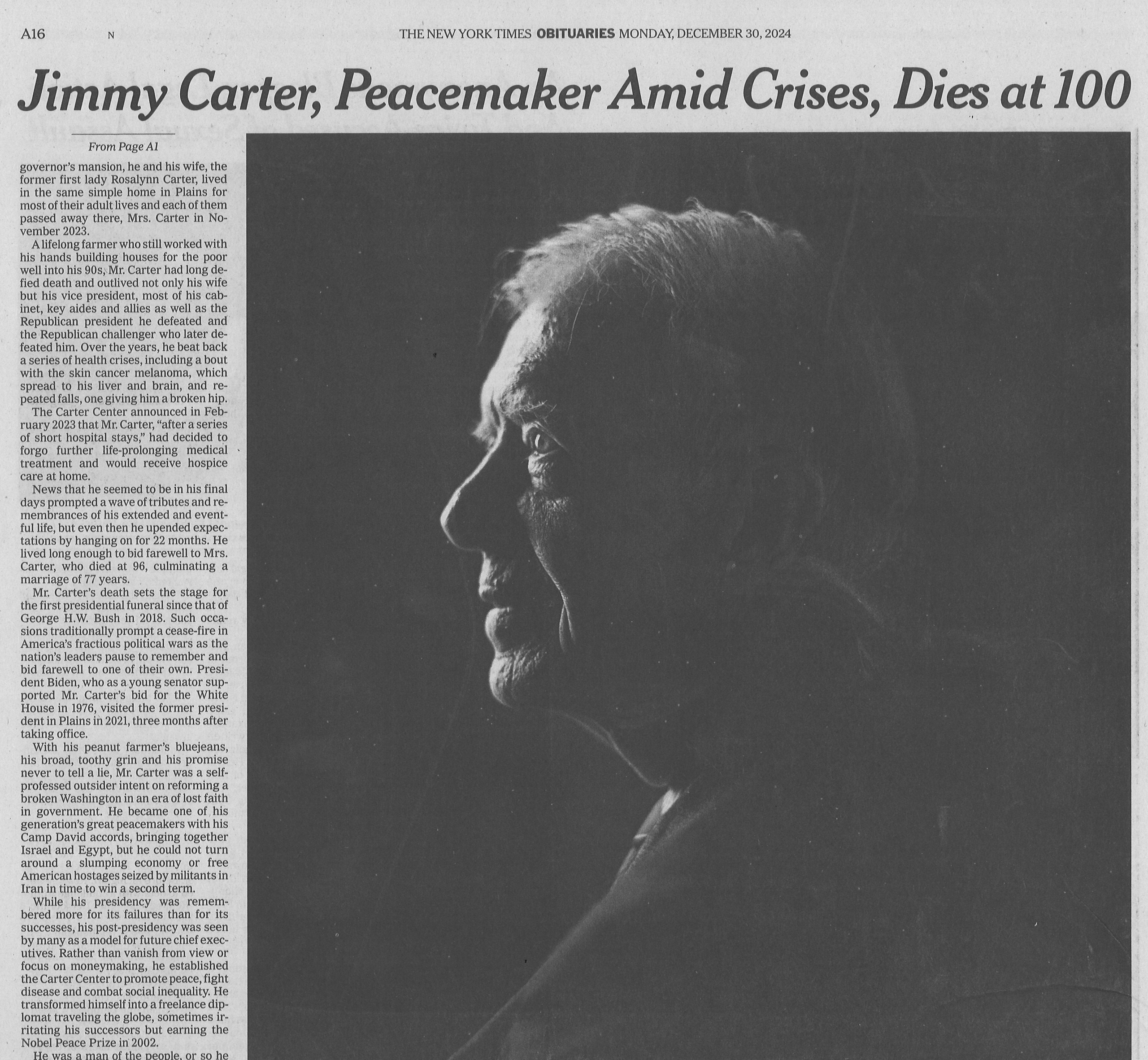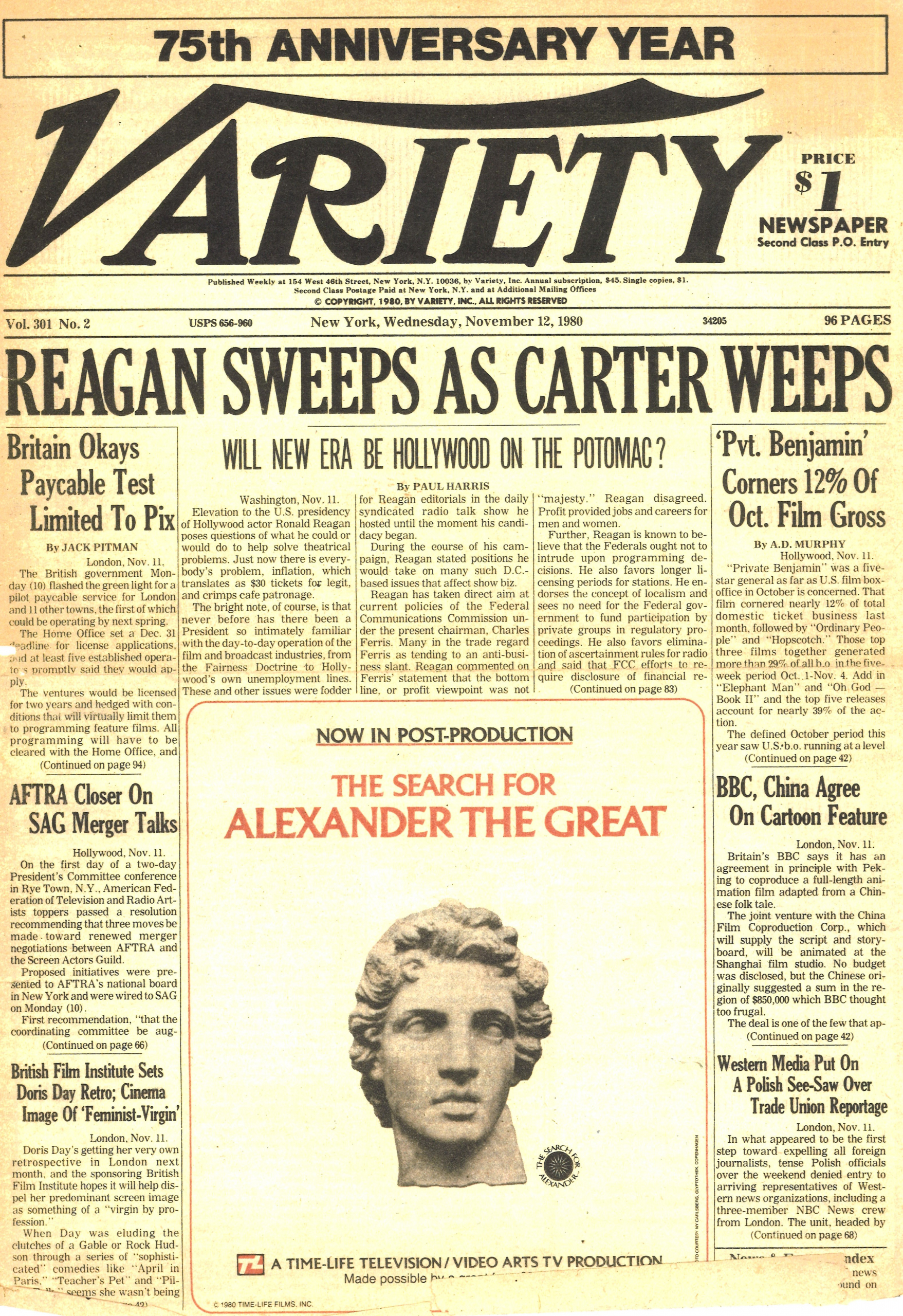On the subject of smoking, President Jimmy Carter was a paradox. Two of his best appointments were Joseph Califano, Jr., a former aide to President Lyndon Johnson, as Secretary of Health, Education and Welfare (HEW) and Harvard pediatrician Dr. Julius Richmond as Surgeon General and Assistant HEW Secretary. The Surgeon General’s Report of 1979, written under their guidance and released on the 15th anniversary of the publication of the first report by the Surgeon General on smoking and health, was the most comprehensive document on smoking ever published by the federal government. A year later, the Surgeon General’s Report on the health consequences of smoking for women made front-page news around the world. Carter’s other significant contribution to fighting tobacco use was his appointment of Dr. Vincent DeVita to head the National Cancer Institute (NCI). Under DeVita and his cancer prevention director Joe Cullen, the NCI changed course from trying to find a safer cigarette to promoting ways to get people to stop smoking.
Ultimately, though, President Carter’s major contribution to anti-smoking efforts was his firing of Califano for having incurred the wrath of voters in tobacco-growing states, which sparked public outrage and drew even greater attention to the issue. It was best summed up in the headline, “Carter fired Califano for doing his job”. The author of that column, conservative William Buckley, was no friend of Democrats, but he saw past Califano’s public letter of resignation. Buckley recognized that he’d been booted because of his “anti-tobacco stand, which hurt the feelings of tobacco growers.” Even President Ronald Reagan, who quipped before assuming office that he would be too busy to deal with issues like smoking, unwittingly made a greater contribution than President Carter to tackling tobacco-related health problems by his appointment of Dr. C. Everett Koop as Surgeon General. Although most public health and medical organizations opposed Koop’s nomination because of his outspoken opposition to abortion, he would soon become the national voice of the anti-smoking movement — or the new head of the nanny state, according to his detractors in tobacco country.
In September 1985, nearly five years after leaving office, former President Carter convened a conflict resolution retreat on the tobacco issue at Calloway Gardens, Georgia, patterned after his Camp David meetings to forge a peace accord in the Middle East. He invited the heads of major health organizations, tobacco growers, elected officials from tobacco-growing states, tobacco industry executives, and anti-smoking activists – thirty participants in all. Although only one tobacco industry representative attended the retreat (the director of the Smokeless Tobacco Council), most tobacco state agriculture commissioners were there, as were the heads of the American Cancer Society, the American Heart Association, the American Lung Association, the American Public Health Association, and Doctors Ought to Care. It was arguably the first time that face-to-face discussions were held between pro-tobacco interests and anti-smoking groups. This exhibition features documents from the three-day conflict resolution retreat at Calloway Gardens.
Participants ultimately agreed on two main points: that the tobacco farmer wasn’t the main obstacle to curbing teen smoking — the cigarette manufacturers were — and that America’s adolescents needed stronger education on the harmfulness of smoking. Dayle E. Powell, JD, the founding Director of the Conflict Resolution Programs at the Carter Center at Emory University, wrote about the tobacco symposium, which she coordinated, in an essay in the Negotiation Journal, which is included in this exhibition. In May 2024, Powell, now Dayle E. Spencer, offered this remembrance:
“The symposium had two significant outcomes. First it led to a compromise between the smokeless tobacco industry and the health advocates to jointly support legislation that became the Smokeless Tobacco Act of 1986, which forbade advertising of smokeless products on TV and radio [which had not been included in Congress’s 1971 broadcast ban on cigarettes ads], and required disease specific warning labels on all smokeless products. Second, this early success caused the Carter Center to pivot to international conflicts such as Ethiopia and Eritrea, Sudan and South Sudan, and North and South Korea.
“The tobacco symposium was a test case that proved the model we later used in civil war situations throughout the world.”
In recent years, although the Carter Center has not focused its attention on the world tobacco pandemic, it has been dedicated to eradicating global parasitic diseases such as guinea worm and schistosomiasis.
Alan Blum, MD
Director, The Center for the Study of Tobacco and Society
May 24, 2024
From Governor to President…
“The ‘never before’ menthol.” / “Dixie Whistles A Different Tune: Georgia Governor Jimmy Carter”
Back cover advertisement by R.J. Reynolds Tobacco Company for Vantage cigarettes, cover photograph of Governor Jimmy Carter
TIME Magazine
May 31, 1977
“Demos Pick Carter; Mondale VP Choice” Atlanta Journal, July 15, 1976
“Carter a new Nixon, GOP attack claims” Miami News, August 9, 1976
“Ford and Carter Fight It Out” Miami Herald, September 24, 1976
“Ford, Carter race nearly dead heat” Miami News, November 1, 1976
“NATION CASTS UNEXPECTEDLY HEAVY VOTE IN FORD, CARTER RACE FOR PRESIDENT” New York Times, November 3, 1976 (5 pages)
“CARTER WINS: Ford Vows His Support In Conceding”
Front page
The Atlanta Journal
November 3, 1976
“Carter Is Sworn In As 39th President: Urges New Spirit of Unity and Trust”
Front page
The Atlanta Journal
January 20, 1977
“I Have Chance to Be Great President, Carter Says”
Article by James MacCartney
The Miami Herald
January 28, 1977
As President…
“Calfano Named HEW Secretary”
Associated Press Wirephoto of President-elect Carter and Joseph A. Califano, Jr.
December 24, 1976
“President Carter wanted me to mount a health promotion and disease prevention program. I sought the opinion of every physician — more than a hundred — I was interviewing ‘for HEW posts. Without exception, each said there could be no credible effort unless we went after cigarette smoking. We conducted a survey, which revealed that virtually every addicted adult smoker first lit up and was hooked as a teen, well before reaching age twenty-one, and that most had tried to quit within the last year. That set me on the course of an aggressive public information campaign.
“I announced the anti-smoking campaign on January 11, 1978, the fourteenth anniversary of the first surgeon general’s report, Smoking and Health. Thanks to my speechwriter, Ervin Duggan, I called smoking ‘slow-motion suicide’ and designated it ‘Public Health Enemy Number One.’ I decreed that all HEW buildings must be smoke-free, and I pressed other government agencies to follow suit.
“The Washington Evening Star banner-headlined ‘Califano Declares War On Smoking.’ The tobacco industry immediately counterattacked. The Kentucky legislature called for my impeachment. Red-and-white bumper stickers sprouted up across tobacco states proclaiming, ‘Califano Is Dangerous To Your Health,’ a play on the warning then printed on every cigarette pack. Southern politicians and close political advisors told Carter that he could not carry North Carolina, Virginia, and Kentucky, perhaps even Georgia, in 1980 unless I abandoned the anti-smoking campaign. Some, like North Carolina governor Jim Hunt, urged the President to fire me, noting that in addition to the anti-smoking campaign I was hurting the President’s chances for reelection by pressing southern states to provide equal opportunity and comparable facilities at predominantly black universities and publicly embarrassing them by bringing attention to the enormous disparity compared with predominantly white colleges…”
Excerpt from Inside: a public and private life by Joseph A. Califano, Jr., New York: PublicAffairs, 2004
“Anti-Smoking Ads
Califano Dares Tobacco Industry”
News article by Maitland Zane
San Francisco Chronicle
January 12, 1978
“I don’t think there needs to be any concern about that, and nobody need fear the facts about tobacco use. Certainly, no one need fear the emphasis on research that will make the use of tobacco in the future even more safe than it has been in the past.”
PRESIDENTIAL DOCUMENTS: Informal Question-and-Answer Session with Reporters
Winston-Salem, North Carolina
March 17, 1978
Curator’s note: The hue and cry in tobacco-growing states over HEW Secretary Califano’s vocal campaign against smoking led President Carter to visit North Carolina to offer reassurances to tobacco farmers that research would help make smoking in the future “even more safe than it has been in the past.”
“ANTI-SMOKING CAMPAIGN
“Q: You spoke favorably of North Carolina as a tobacco-producing state. Does this mean you’re calling off Secretary Joseph Califano off the anti-smoking campaign?
“THE PRESIDENT: No. Joe Califano has a responsibility, as Secretary of HEW, to protect and enhance the health of American people…
“Tobacco, in some instances, is damaging to our Nation’s health, particularly among very young children and those who have respiratory diseases. We have only a $30 million budget on tobacco in HEW. This is all that Joe Califano asked for, and I think that’s what he’ll get. Two-thirds of that budget is for research. And I don’t think that anyone who grows tobacco in Winston-Salem or North Carolina or Georgia or other States that produce tobacco would say that the research program in recent years has not been beneficial…
“So, I would say there’s a well-balanced campaign to protect the health of our Nation, which is Joe Califano’s responsibility, on the one hand, and to preserve the health and stability of the tobacco industry, which is under Bob Berglund, Secretary of Agriculture, and myself.
“Hot Issue: HEW’s Califano Ends His Anticigaret Drive; Burns Up Many People; He Is Attacked by All Sides But Also Wins Support; Is Carter Hurt in South?”
Front-page portion of article by Rich Jaroslov and Douglas R. Sease
The Wall Street Journal
May 1, 1978
“President to Visit Tobacco Country
To Attempt to Bolster Candidates”
Article by Wayne King
The New York Times
August 5, 1978
“Just how much damage Mr. Califano’s antismoking campaigns are doing to President Carter’s popularity… appears to have been forcefully brought home to President Carter.
“Tomorrow, the President will visit Wilson, a town of about 30,000 people…in the heart of tobacco country.
“The President will make what a White House aide…called a ‘symbolic visit’ to Growers Warehouse, the site of the world’s biggest bright leaf tobacco auction.”
Click here for a preview of a related exhibition-in-progress:
“1985: North Carolina takes a hard look at the ethics of growing tobacco”
“‘I THINK ALL THIS SMOKE HAS AFFECTED MY EYES'”
Editorial cartoon by Herb Block
The Washington Post
1979
“Smoke Gets in Your Eyes”
Editorial cartoon by Herb Block
The Washington Post
1977
“’THEY KEEP TALKING ABOUT LIFE AND DEATH –
WE’VE GOT MONEY AT STAKE HERE!’”
Editorial cartoon by Herb Block (1909 – 2001)
Syndicated by The Washington Post
1979
[The tobacco industry and Joe Califano]
Editorial cartoon by Tony Auth (1942 – 2014)
The Philadelphia Enquirer (syndicated by The Washington Post Group)
July 1979
“Califano Crusade Goes Up In Smoke”
Excerpt of article by Rudy Abramson
The Los Angeles Times (reprinted in The Atlanta Journal)
October 12, 1978
“WASHINGTON — The war was declared with a fusillade of headlines last winter. The federal government, led by Health, Education, and Welfare Secretary Joseph A. Califano, Jr., was about to attack the cigarette-smoking habit from the tobacco patches of Kentucky to the smoke-filled rooms of the nation’s capital.
“Fourteen years after a massive study had statistically proven the link between cigarette smoking and lung cancer, the government was going to get serious about discouraging the habit. The time had come, Califano declared, for a new initiative in one of the world’s most fertile fields of public health, to suppress a habit estimated to cost hundreds of thousands of lives each year — not to mention the $3 billion to $7 billion in medical bills and as much as $18 billion in productivity lost because of absenteeism.
“He was a fervent anti-smoker, two years reformed from a heavy habit. He headed a bureaucracy that touched more Americans than any other except the Census Bureau and the Internal Revenue Service. He was an old hand at the rough-and-tumble game of intramural Washington politics. And during his one year in office, he showed an uncommon willingness to ruffle feathers, take risks, and put himself in the spotlight.
“But now, eight months later, his war has — to put it charitably — been little more than a skirmish.
“President Carter himself had a big hand in blunting the assault; the tobacco lobby showed that it was more than a match for a government bureaucracy, and even Califano’s natural allies, the antismoking activists, ridiculed the initiative as little more than hot air…”
“CALIFANO OUT”
Associated Press Laserphoto
July 19, 1979
“Health Education and Welfare Secretary Joseph Califano faces reporters during a news conference Thursday in Washington. Califano tendered his resignation and it was accepted by President Carter earlier in the day.”
As Ex-President…
Letter from President Jimmy Carter to Alan Blum, MD inviting him to be a participant at the Conflict Resolution Symposium on Tobacco; letter from Dayle Powell to Dr. Blum describing details of the conference (4 pages)
July 1 and 25, 1985
“Creative Approaches to Resolution of Conflict in Modern Society: Tobacco”
Cover of participants’ packet for the conflict resolution retreat on tobacco at Calloway Gardens, Georgia, autographed by Jimmy Carter
THE CARTER CENTER OF EMORY UNIVERSITY
September 8-10, 1985
“Agenda for Symposium on Creative Approaches to Resolution of Conflict in Modern Society: Tobacco” (3 pages)
September 8-10, 1985
Objectives of the Carter Center on Conflict Resolution with sketch of Jimmy Carter by Alan Blum, MD
September 9, 1985
“Defining the Issues: Small Group Sessions” (4 pages)
The Carter Center Symposium on Conflict Resolution in Modern Society: Tobacco
September 8-10, 1985
List of Participants at Carter Center Conflict Resolution Symposium on Tobacco (4 pages)
September 8-10, 1985
Issues for Discussion
Notes by Alan Blum, MD
“compete
collaborate
compromise
avoid
accommodate”
Notes and sketches of participants by Alan Blum, MD at the conflict resolution conference on tobacco, convened by former President Carter at Calloway Gardens, Georgia (12 pages)
September 8-10, 1985
1. Rosalyn and Jimmy Carter with Rick Richards, MD (at right) and Alan Blum, MD of Doctors Ought to Care, photographed at the conflict resolution retreat on tobacco, Calloway Gardens, Georgia
2.Former President Carter and Dr, Blum (2 pages)
September 9, 1985
Letter from Jimmy Carter to Alan Blum, MD expressing appreciation for attending the Conflict Resolution Symposium on Tobacco; thank you letter from Dr. Blum to President Carter; thank you letter from Dayle Powell to Dr. Blum (3 pages)
September 20, 1985, October 7 and 16, 1985
“Carter urges ban on tobacco advertising”
Article by Linda Bosy reporting on former President Carter’s plenary address to the 114th convention of the American Public Health Association in Las Vegas
September 28 to October 3, 1986
American Medical News
(Published by the American Medical Association)
October 1986
“Former President Jimmy Carter called cigarets and tobacco products among the world’s greatest health threats, and highly praised the American Medical Association for its ‘progress’ in taking a strong stand against tobacco use.
“‘There is a deliberate attempt on the part of the tobacco industry to cause death for profit; this is one of the worst crises there is,’ Carter said as he called for a ban o all tobacco advertising in this country.
“‘I don’t see that a constitutional issue of free speech i involved here — those who control the major media should not accept cigaret advertising,’ he said.”
“Conflict Resolution Symposium Derails a Potential Tobacco ‘War'” (4 pages)
Article by Dayle E. Powell, JD*
Negotiation Journal
January 1989, pages 75-82
“President Carter decided to focus on tobacco as the inaugural work of the [Carter] Center’s program on conflict resolution…”
“The goal of these meetings—which were staffed by a group of mediators skilled in conflict resolution processes—was not to resolve, or even attempt to resolve, the many issues related to the tobacco controversy. Participants in these meetings maintained positions that were unchangeable, and converts from one position to another were highly unlikely. Rather, the purpose of the session was to empower the parties themselves to work toward resolution of those issues that could be negotiated, and to do so through negotiation processes that may be more cost-effective and timely than litigation, lobbying, and traditional bargaining.”

